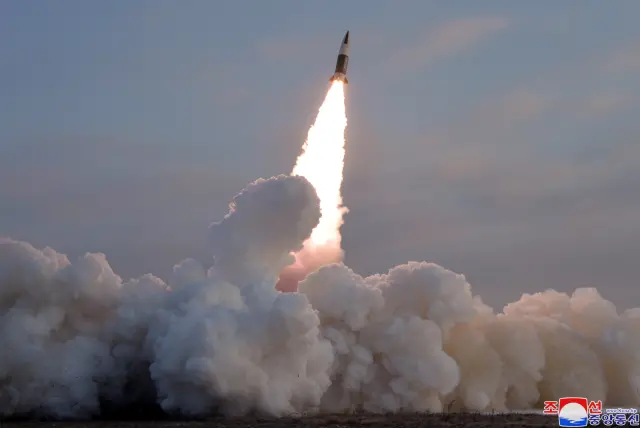This show of missile tests by North Korea was a retaliation to the ongoing largest ever joint military drill of South Korea and the US, in which thousands of military personnel and 240 aircraft were taking part. At a time when the USA is already engaged in multiple global challenges like the Ukraine war, the Russian threat of using nuclear weapons, Iran’s nuclear plans, and deteriorating relations with China on the Taiwan issue, opening up another front to comply with its security agreements with Japan and South Korea is another challenging task for US and North Korea knows it very well.
Last month (November,2022), the tension on the Korean peninsula escalated after North Korea fired 23 missiles in one day on 2nd November and then launched another six missile the next day; one of which was suspected be an intercontinental ballistic missile. Japan claimed that one of these missiles had flown over its territory and it was the second occurrence in a month. South Korea reacted by firing several missiles on the next day.
Earlier, a missile was fired by North Korea that had crossed the maritime border with South Korea for the first time and caused a panic leading to televised announcements for the residents of the border area to “evacuate to the nearest underground shelter”.
This show of missile tests by North Korea was a retaliation to the ongoing largest ever joint military drill of South Korea and the US, in which thousands of military personnel and 240 aircraft were taking part.
In response to this provocative military exercise, North Korea had warned that it might take “more powerful follow-up measures” from Pyongyang[1]. What happened on 2nd November was in line with this warning but there are more reasons for the rise of tension in the region.
It wasn’t the first time North Korea had fired missiles directed towards the Sea of Japan or South Korea. On 28 September, it fired two short-range ballistic missiles off its east coast a day before the arrival of US Vice President Kamala Harris in Seoul. Two days later, South Korea and US forces had to conduct a military drill in waters off the South’s east coast[2].
Japan and South Korea have a security alliance with the United States and there exists the largest active bases of American troops in both of these countries. These security alliances legitimize US involvement in the region and it takes measures that can prove its ability to protect its allies from any aggressive design of their enemies. At a time when the USA is already engaged in multiple global challenges like the Ukraine war, the Russian threat of using nuclear weapons, Iran’s nuclear plans, and deteriorating relations with China on the Taiwan issue, opening up another front to comply with its security agreements with Japan and South Korea is another a challenging task for US and North Korea knows it very well.
Attending the 17th East Asia Summit in Cambodia, the US. President, Joe Biden, met with Japanese Prime Minister Fumio Kishida and South Korean President Yoon Suk Yeol and had them onboard for a unified and well-coordinated response to the threatening postures of the North Korea. They also reviewed all other options including the use of Chinese influence on North Korea to de-escalate the tension in the region.
In a press briefing after the first face-to-face meeting with the Chinese President, Joe Biden issued a warning: “Xi needed to attempt to make it clear to close ally North Korea that launching “long-range nuclear tests” was unacceptable and that if Pyongyang ignored Xi, the U.S. would take certain “defensive” actions to “send a clear message to North Korea.”
If all attempts to dissuade North Korea from its aggressive gestures fail, the clear message, as contemplated by the US and its allies, is to have larger presence of American forces in the region and re-apply the sanctions regime that was lifted by Donald Trump back in 2018 before initiating his summit-level diplomacy with North Korean President Kim Jong-un.
On the next day of this US warning, North Korea carried out its second and largest intercontinental ballistic missile test in this month exhibiting its ability to launch nuclear strikes that can target the US mainland. USA condemned this test repeating the same warning it issued earlier. Despite US warnings, North Korea boasted about its plans to become the world’s strongest nuclear force, thwart any nuclear threat to the country and protect the dignity and sovereignty of the state and the people. The US expressed its displeasure by pleading with the United Nations Security Council to hold North Korea accountable for defying the ban imposed by the Security Council resolution against the missile tests.
The continued obstinacy of North Korea to pursue its deterrent plans appears to have blessings from China and Russia which have opposed US moves to toughen its stance on curbing North Korea’s nuclear program. In a message to Kim, Chinese President Xi Jinping conveyed his willingness to work with Pyongyang as changes in the world, times, and history are taking place in unprecedented ways. With the ongoing rate of missile testing, it is highly unlikely to have peace in the region. All global powers have to take another look at their policies and devise strategies that can de-escalate the tension in the area before it goes beyond control.
[1] https://www.reuters.com/world/north-korea-calls-united-states-south-korea-stop-joint-military-exercises-2022-10-31/
[2] https://www.dawn.com/news/1712513/north-korea-fires-two-missiles-as-us-vp-due-in-seoul




